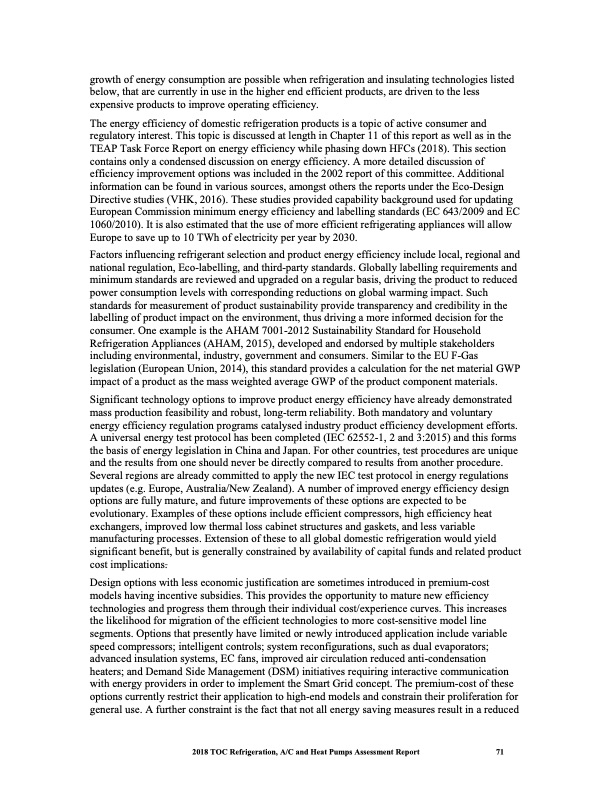
PDF Publication Title:
Text from PDF Page: 084
growth of energy consumption are possible when refrigeration and insulating technologies listed below, that are currently in use in the higher end efficient products, are driven to the less expensive products to improve operating efficiency. The energy efficiency of domestic refrigeration products is a topic of active consumer and regulatory interest. This topic is discussed at length in Chapter 11 of this report as well as in the TEAP Task Force Report on energy efficiency while phasing down HFCs (2018). This section contains only a condensed discussion on energy efficiency. A more detailed discussion of efficiency improvement options was included in the 2002 report of this committee. Additional information can be found in various sources, amongst others the reports under the Eco-Design Directive studies (VHK, 2016). These studies provided capability background used for updating European Commission minimum energy efficiency and labelling standards (EC 643/2009 and EC 1060/2010). It is also estimated that the use of more efficient refrigerating appliances will allow Europe to save up to 10 TWh of electricity per year by 2030. Factors influencing refrigerant selection and product energy efficiency include local, regional and national regulation, Eco-labelling, and third-party standards. Globally labelling requirements and minimum standards are reviewed and upgraded on a regular basis, driving the product to reduced power consumption levels with corresponding reductions on global warming impact. Such standards for measurement of product sustainability provide transparency and credibility in the labelling of product impact on the environment, thus driving a more informed decision for the consumer. One example is the AHAM 7001-2012 Sustainability Standard for Household Refrigeration Appliances (AHAM, 2015), developed and endorsed by multiple stakeholders including environmental, industry, government and consumers. Similar to the EU F-Gas legislation (European Union, 2014), this standard provides a calculation for the net material GWP impact of a product as the mass weighted average GWP of the product component materials. Significant technology options to improve product energy efficiency have already demonstrated mass production feasibility and robust, long-term reliability. Both mandatory and voluntary energy efficiency regulation programs catalysed industry product efficiency development efforts. A universal energy test protocol has been completed (IEC 62552-1, 2 and 3:2015) and this forms the basis of energy legislation in China and Japan. For other countries, test procedures are unique and the results from one should never be directly compared to results from another procedure. Several regions are already committed to apply the new IEC test protocol in energy regulations updates (e.g. Europe, Australia/New Zealand). A number of improved energy efficiency design options are fully mature, and future improvements of these options are expected to be evolutionary. Examples of these options include efficient compressors, high efficiency heat exchangers, improved low thermal loss cabinet structures and gaskets, and less variable manufacturing processes. Extension of these to all global domestic refrigeration would yield significant benefit, but is generally constrained by availability of capital funds and related product cost implications. Design options with less economic justification are sometimes introduced in premium-cost models having incentive subsidies. This provides the opportunity to mature new efficiency technologies and progress them through their individual cost/experience curves. This increases the likelihood for migration of the efficient technologies to more cost-sensitive model line segments. Options that presently have limited or newly introduced application include variable speed compressors; intelligent controls; system reconfigurations, such as dual evaporators; advanced insulation systems, EC fans, improved air circulation reduced anti-condensation heaters; and Demand Side Management (DSM) initiatives requiring interactive communication with energy providers in order to implement the Smart Grid concept. The premium-cost of these options currently restrict their application to high-end models and constrain their proliferation for general use. A further constraint is the fact that not all energy saving measures result in a reduced 2018 TOC Refrigeration, A/C and Heat Pumps Assessment Report 71PDF Image | Heat Pumps Technical Options

PDF Search Title:
Heat Pumps Technical OptionsOriginal File Name Searched:
RTOC-assessment-report-2018_0.pdfDIY PDF Search: Google It | Yahoo | Bing
CO2 Organic Rankine Cycle Experimenter Platform The supercritical CO2 phase change system is both a heat pump and organic rankine cycle which can be used for those purposes and as a supercritical extractor for advanced subcritical and supercritical extraction technology. Uses include producing nanoparticles, precious metal CO2 extraction, lithium battery recycling, and other applications... More Info
Heat Pumps CO2 ORC Heat Pump System Platform More Info
| CONTACT TEL: 608-238-6001 Email: greg@infinityturbine.com | RSS | AMP |